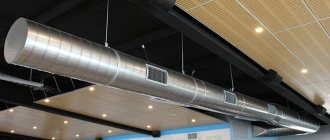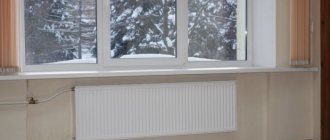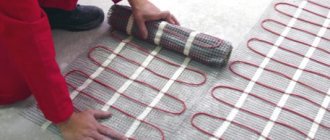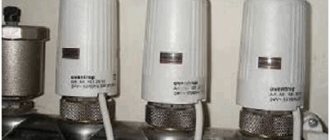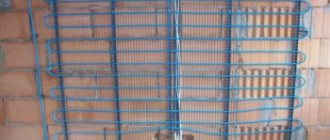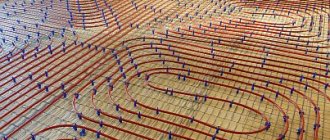Although “warm floors” are not an essential product, their installation in residential buildings is very popular. Often homeowners equip it in those rooms that are poorly heated by central heating. Let’s figure out how much power of a “warm floor” is needed depending on the area of the room. And how to minimize the costs of paying for it.
Heated floor system Source santehmarka.ru
Choosing the design of floor heaters
Whatever the heating design, the system must be warmed up to operate. And how quickly it reaches the set mode will depend entirely on the power of the “warm floor” per 1 m². And you need to start from the role of underfloor heating.
If this is the only source of heating the room, then you will need up to 200 W per square meter. When the “warm floor” only helps the main radiators, then the need can be reduced to half or one and a half times. And then 100-150 W per meter of housing will be enough.
Any of the “warm floor” designs has similar power. The owner of both an apartment and a country house can always choose a profitable system for himself. After all, any of them can save up to 15% of energy resources in comparison with radiator heating.
Cable circuit
A very common system because the material is inexpensive. True, in order to reduce inevitable heat losses, you will have to install either a reinforced screed or use self-leveling floors. But it will quickly pay off.
Cable circuit Source 1-teplodom.ru
The owner will have to choose from two cable options. Typically, single-core is used if a system is installed to assist the main heating. And in this case, you won’t have to worry too much about how much the electric “warm floor” consumes. Because the consumption will be minimal.
But if the system will completely and independently heat the room, then you need to take a two-core cable. This will prevent you from closing the loop on the thermostat during reverse operation. True, in this case you will have to work hard during installation to get 200 W per square meter. To do this, you need to lay the wire much tighter than usual.
Experts advise not to lay a contour under the furniture, and also not to cover the surface with thick carpets. Why greatly disturb heat exchange or heat objects rather than air. This will unnecessarily increase energy consumption. And so, you may need a lot of it, because for effective heating it is necessary to cover the room by at least 70%.
See also: Catalog of companies that specialize in home insulation
Cable mats
Manufacturers produce two types of designs. Some need to be placed under a concrete screed. But the latter should not be too thick. In this case, thin cables on a mesh will warm up the surface faster.
Mats with a hardened surface do not require screed. They have a layer of thermal insulation. And you can immediately install flooring on them.
Thermomat Source allelectrics.ru
Infrared film
The most productive system today. Because a film based on carbon material just 3 mm thick has an efficiency of up to 95%. And at the same time, energy consumption is very economical. Coatings are produced in various designs. Some need to be hidden under a thin screed, others can simply be covered with carpet.
Recently, the production of thermomats with carbon rods inside has begun. Such a heater is inferior in power to film, but can be successfully used as additional heating. The mat itself must be laid under the floor covering.
Electricity consumption per 1 m² of underfloor heating film system will be from 100 to 200 W per hour. The power of the rod can range from 70 to 150 W.
Types of heating elements
There are several types of electric heated floors, the power of which directly depends on the type of heating element. Electric floors work on:
| Heating element | Power (W/m2) | Finish type |
| Infrared film | 150 — 400 | Any |
| Electric cable | 120 — 150 | Ceramic tiles, porcelain tiles |
| Thermomat | 120 — 200 | Ceramic tile |
The data is taken as an average; indicators for a particular brand may vary slightly. Thus, it is clear that the installation of any heating system in a room of any type is possible with all options for electric heated floors.
The simplest calculation of electricity consumption
Let's consider how much electricity a “warm floor” consumes and how to make the calculations correctly. Thermal comfort occurs when the room is heated to 70%. And pumping up all possible power can also cause unpleasant sensations for some family members.
Therefore, in order to warm up a room of 15 m², calculations must be made as for a room of 10 m². And if the house uses a structure with an average power of 160 W per square meter, then such a room will need 1.6 kW. This amount of electricity will be consumed every hour when the system is activated.
Experts have calculated that with proper installation of a “warm floor,” the system can operate no more than 6 hours a day. At the same time, thermal comfort will be maintained in the room. Therefore, an average of 280 kW of electricity will be needed per month. And this figure can be reduced by as much as 40%. If you install a programmable thermostat.
Warm floor with infrared heating Source aviarydecor.com
Finish coating - impact on energy costs
When choosing a finishing material for the manufacture of warm electric floors, you need to make sure that there is a special icon that indicates the likelihood of combination with an adjacent heating device.
Often parquet, linoleum, laminate or ceramic tiles are used as the main material.
Another important factor for calculating the level of electrical energy consumption per square meter is the thermal conductivity of the finish. For example, wooden flooring or laminate flooring has an insignificant degree of heating, therefore, the cost of manufacturing floors will increase significantly.
If we are talking about saving money, then it is better to give preference to linoleum, ceramic tiles or carpet. The materials in question heat up quickly, which significantly reduces energy consumption.
Laying an electric floor with linoleum:
Briefly about the main thing
You can always save on electricity bills. Moreover, this must be done without losing amenities. And to do this, you need to correctly plan and calculate the power of the “warm floor” for the entire house. If you select all the controllable elements correctly, the comfort of your stay will not suffer at all.
Moreover, economical operating modes and accompanying programs will not only have a beneficial effect on the family budget, but will also guarantee the longevity of the system. And if there are difficulties in making calculations, then the Internet is literally teeming with various calculators. But it is better to contact specialists. This way you can avoid various mistakes.
We reduce costs
Thanks to the use of a thermostat, you can save up to 40% of electricity
. The convenience and comfort created by heated floors is overshadowed by only one factor - the electricity bill. How can you reduce your energy costs without depriving yourself of convenience? Some tips for smart consumption:
- Be sure to install a thermostat. It is better to locate it as far as possible from the main heating system. Regulators allow you to save up to 40% of electricity due to the necessary activation.
- Reduce heat loss as much as possible. If necessary, carry out thermal insulation work on the walls. According to experienced statistical studies, improving thermal insulation reduces energy costs by almost 2 times.
- Install a multi-tariff electricity payment system. At the same time, heating floors at night will cost 1.5 – 2 times less, depending on the region.
- Start saving at the installation stage. Do not place heating elements in furniture locations; make the necessary distances from walls and heating devices.
- And simple mathematics: by lowering the temperature by just 10C, electricity consumption is reduced by 5%.
Approach the issue of laying heated floors responsibly. Calculate the required power of the devices in advance. This data will help you choose the right heating elements and use the system without significant damage to the family budget.
Laying film to save energy
It is good to lay a layer of reflective film on top. There is a special foil film with convenient metric markings that allows you to correctly lay the heating cord. You should not lay the cord without markings, and applying markings manually is quite tedious.
Laying foil film
Cunning marking devices made from ropes quickly break and get tangled. For normal installation of the cord, you need to use the factory markings.
Heating a house only with underfloor heating is unprofitable, since this results in pure electric heating.
Warm floors must be wisely combined with the installation of heating radiators.
How the type of premises affects the calculation of underfloor heating costs
It is recommended to use equipment of a specific power for each room. This is determined by the following standards:
- bathroom - 0.15 kW/m²;
- kitchen, corridor, bedroom, hall - Up to 0.12 kW/m²;
- loggia - 0.2 kW/m².
In addition, the power may be affected by the nature of the equipment. That is, for what purpose is it intended - for main or additional heating.
For example, you can take into account a room with an area of 20 m², in which the usable area is only 8 m². Provided that the main source is used, the heat loss rate will vary from 1 to 2 kW/h. Power can be calculated using the following formula:
2 (heat loss) divided by 8 (area). The result is 250 W/h.
Healthy! You will need to add 25% to the calculation if the home is located in a harsh cold climate.
Electric matte heated floor
Warm floors of this type are an affordable way to heat a room, which has already been tested by a large number of people. There is nothing complicated in the design of an electric heated floor; it contains a thermostat, a temperature sensor and a heating cable.
The heating element can be single-core or double-core. They are almost the same, the only difference is that they need different gaskets. For a two-core one to work, you only need to connect one side to the electrical network, and a single-core one needs to connect to both. That is why the two-wire one is more convenient, more profitable and costs more.
As for the cable diameter, it can be from two to ten millimeters, while the power always remains the same. The cable diameter is selected depending on the type of tie chosen.
Sometimes an electric heated floor looks like a regular cable, and sometimes it looks like a mesh with a cable attached to it. It is this mesh base with cable that is called a “matte” floor. This type of flooring is the most popular because it allows for uniform heat distribution throughout the entire floor. Unfortunately, “matte” heated floors are only suitable for thin screeds.
The warm floor can be covered with almost any covering. Before purchasing the material, you need to clarify the possibility of using this coating for electric heated floors. It must be remembered that if you place a thick carpet on the floor that does not transmit heat well, then having a heated floor in the room will simply be pointless.
Recommendations for choosing screed thickness
In the reference books you can find information that the minimum thickness of the screed is 30 mm. When the room is quite high, insulation is placed under the screed, which increases the efficiency of using the heat given off by the heating circuit.
The most popular backing material is extruded polystyrene foam. Its heat transfer resistance is significantly lower than that of concrete.
When installing a screed, in order to balance the linear expansion of concrete, the perimeter of the room is decorated with a damper tape. It is important to choose the right thickness. Experts advise that for a room area not exceeding 100 m², install a 5 mm compensating layer.
If the area values are larger due to the length exceeding 10 m, the thickness is calculated using the formula:
b = 0.55*L , where
L is the length of the room in m.
Warm floors by type - comparative analysis of costs
Induction heating of the top layers occurs in all electric floors. The process is carried out due to electric current, as a result of which thermal energy appears from electricity. In this case, the efficiency is identical for all types. It is worth noting that the installation method and the top layer directly affect the energy consumption of heated floors. A huge role is played by such nuances as the coefficient of reflective material, the thermal insulation layer and the level of heat loss in the screeds.
Based on the information provided, we can conclude that equipment that is installed under the top layer of decorative material is considered more productive. It is also possible to significantly reduce the main differences between products. This is due to the possibility of installing reliable insulation and reflector.
It is worth noting that there are still differences between all types of electric floors. And this despite seemingly minor differences in the material. For example, an experienced craftsman may notice that the film, taking into account a consumption of 0.22 kW, heats up to 40 degrees. A cable tie will require only 0.15 kW to provide a similar temperature.
In order to save money, it is recommended to install a cable tie. In this case, the owner of the premises will provide himself with a sufficient temperature level with minimal energy consumption. High-quality insulation will heat up from scratch within 7-8 hours, after which heating will occur exclusively due to the upper layers of the floor.
However, if we are talking about small rooms, then the differences in energy efficiency will be insignificant. The only thing you need to spend money on is installation.
What will determine the level of comfort in the premises?
Electric underfloor heating consumes very little electricity, which makes the device economical. When choosing the equipment you are interested in, you should pay attention to the power indicator of the device, which is expressed in relation to one meter of area or surface. When developing a project regarding the selection and subsequent installation of film, cable or water coating, a level of heating is provided that would not only be considered optimal, but also incur minimal costs.
Low thermal conductivity of wooden coverings. To warm them up (heat) you will need more powerful heating devices, the power consumption of which will be much greater.
The performance indicator depends on:
- the intended purpose of the room, in which both the material from which the windows are made and the floor covering should be taken into account (this will allow one to determine the level of the optimal microclimate);
- effective area, which is an exclusively free surface, not cluttered with furniture, decorative items or appliances;
- types (types) of heating. If you plan to make an infrared heated floor the only source of heating, then the structure must cover at least ¾ of the entire area of the room. In this case, the performance will be 160-180 W/sq.
Based on the selected device, you should additionally take care of the diameter of the pipes used, the boiler, pumps and other elements.
Tips and tricks
To get the most accurate calculations, it is advisable to seek advice from professionals who specialize in installing internal utilities.
It is possible to use an online calculator, which will facilitate the calculations, but will give very rough calculations that provide general information about the scale of the upcoming installation work.
An example of calculating a water heated floor
To heat old and dilapidated buildings that do not have high-quality insulation, it is not advisable to use a warm water floor system as the only heating element, which is due to the low degree of efficiency and high energy consumption.
The level of technical literacy of all calculations performed has a direct impact on the quality characteristics of the installed heating system. Correct calculations allow you to optimize financial costs not only for the process of installing water floor heating, but also to minimize costs during operation and maintenance of the entire heating system.
